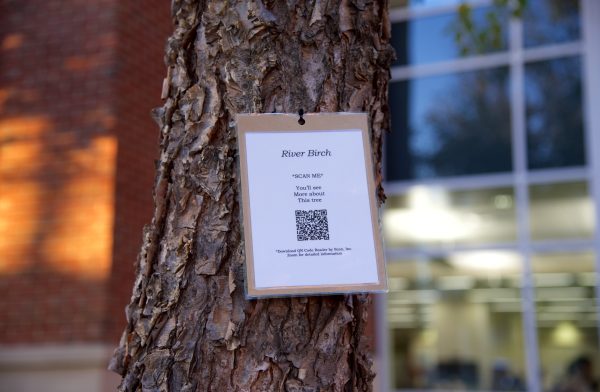Arbor 49er Project “Speaks for the Trees” on Campus

“I speak for the trees, for the trees have no tongues. And I am asking you at the top of my lungs.”
Many of us recognize this quote from Dr. Suess’ book The Lorax from when we were young, but as we grow up we often forget to notice the trees. One exception may be during the fall when the leaves begin to change colors. After all, the fall foliage in the mountains of North Carolina is well known for its astonishing beauty.
That is why I have waited to introduce people to the Arbor 49er project until now, when they are paying extra attention to the trees. You may have noticed the colors, but do you know what kind of trees they are? Do you know anything about them? Do you realize what are they used for? Can you make tea from their flowers? What is that one with the heart-shaped leaves called?
If you have noticed tags hanging from the trees on campus, they are a large part of a local tree project I created on campus to maximize student-ecosystem interaction. As part of the project, students in my Ecology Labs and I chose 49 select separate tree species and took photographs of characteristic features and an overall shot of each tree.
We marked their coordinates with a GPS program and put those coordinates into Google Earth. We wrote a description of characteristics and any notable historical background for each of the 49 trees. This resulted in an interactive map with the exact location, pictures, and characteristics of each of the trees.
On my faculty webpage you can download the map that was published by Google Earth with the trees labeled or unlabeled, in a scavenger hunt format. I use the latter to help teach students tree identification in some of my field courses.
Next, my students and I labeled the physical trees. With help from UNC Charlotte Facilities Management, we obtained money to order bronze placards for each of the 49 trees and establish a fund for their replacement.
As a continuation, in the last phase of the project, we combined the physical and virtual worlds by creating scannable QR codes that allow the campus and broader community to scan each tree and read about their significant characteristics. Once the leaves have fallen, the corresponding information will also allow everyone to see what the trees look like in the summer.
Next time you’re waiting around for your next class to start or passing through campus while enjoying the autumn breeze, if you notice a tag, use that smart phone and scan a nearby tree. Not only will it give you a mental break, but it will foster the kind of appreciation the Lorax always wanted us to have.
As we feel each of our summers grow hotter than the last, we have become more aware of the importance of conservation. And it all starts with the appreciation of our immediate surroundings.
Because, to quote our friend the Lorax, “Unless someone like you cares a whole awful lot, nothing is going to get better. It’s not.”
I would like to thank Joey Cochran for funding the project, Paula Gross with the UNC Charlotte Botanical Gardens for double checking all the labels, my buddy Dan Rubin for telling me I should label the trees on campus to begin with, and Brittany Raines for making all of the QR code cards.
Words: Aaron Kampe, Biological Sciences lecturer | Image: Lynn Roberson